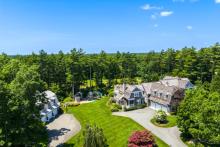Restoring the Sippican River
The following is an open letter from Coalition for Buzzards Bay President Mark Rasmussen to anyone who has questions regarding the Coalition's plan to remove the dam at Hathaway Pond.
In 1804, the Hathaway Dam was built across the Sippican River. Built to power a mill, the dam created a shallow pond in the flooded river valley. It also dramatically and negatively altered the health and fisheries of the river.
The Sippican River is an important tributary to Buzzards Bay. From its wooded swamps and cool springs extending deep into Rochester, the river provides freshwater to the tidal estuary just south of I-195 in Marion. And with that connection, the Sippican joins the wider Bay ecosystem providing a critical link for fish and other wildlife that depend on this rich interplay between fresh and saltwater.
We know from the historical records of the Sippican and coastal streams like it all around Buzzards Bay, that these areas hosted a staggering diversity of fish. Before the dam, the Sippican teamed with river herring, shad, brook trout, smelt, and eels – all diadromous fish that spend part of their lifecycle in both freshwater and the Bay. Fishermen know these fish by a simpler name – Bait. Ask a fisherman casting into the Cape Cod Canal what thousands of herring stacked up trying to cram themselves into a stream brings. They bring behind them a lot of big Striped Bass and Bluefish.
These fishes likely disappeared in the Sippican shortly after the construction of the Hathaway Dam. The Town of Rochester took control of the herring fishery on the Sippican in 1808 and we expect that it might have been then that a fish ladder of some sort was built to try to allow some herring and eels to bypass the dam. But not the brook trout, shad, and other native fishes who can’t use ladders. They’ve been gone from the mainstem of the Sippican for a very long time now.
Furthermore, the fish ladder has never properly functioned at Hathaway Dam.
Somewhere around the turn of the 19th century, new challenges arose for the Sippican’s fish when Hathaway’s Mill began allowing cranberry growers to also use the water in the pond for their bogs. To the physical barrier of the dam was added occasional low flows where the river is drained to irrigate and flood cranberries and poor water quality.
Periodically over the past century – notably in 1920, 1972 and today - state officials have assessed the problems in the Sippican and each time they have come up with the same conclusions: the Hathaway Dam combined with the pressure of having it serve adjacent cranberry bogs impedes fisheries and contributes to degraded water quality.
All of this important history brings us up to the present. Between 1995 and 2006, an Alewives Anonymous fish counter installed at Leonards Pond just upstream of Hathaway found no more than 957 fish in the best year. The Sippican River should have hundreds of thousands of river herring each year, not mere hundreds. Also, new data collected in the past few years confirms the poor state of water and habitat quality in the river and ponds.
Today, the dam that created this mess in the first place is falling apart. Its poor condition is well documented and uncontested. The state Office of Dam Safety has given it its lowest safety ranking and ordered that no water be impounded behind the dam until it is either repaired or removed.
We believe that now is finally the time to restore the Sippican River.
In May of this year, the Buzzards Bay Coalition purchased the Hathaway Dam property to remove the dam - finally bringing back the fish and reconnecting a healthy Sippican to the Bay. In doing so, we also will create a new, easily-accessible place for people to use and enjoy the river for walking, horseback riding, fishing, and kayaking. A new trail and bridge across the restored river will connect the property with miles of adjacent trails.
Our restoration plans are currently under development and we expect to file for local and state permits to remove the dam this fall. We are excited to share what we’ve learned about the potential to restore fish, wildlife and water quality to the Sippican River and look forward to a broad discussion about the merits of dam removal.
Removing the Hathaway Dam will change the view of a pond and replace it with a winding river and open, wet meadow. The end result will be beautiful, however different.
And removing the dam will challenge Beaton’s Inc., a large cranberry company, to rethink decades of water use practices that put their bogs in conflict with the health of the Sippican River. More sustainable alternatives to construct modern reservoirs that don’t rely on the Sippican exist for Beaton’s Inc. and we are eager to assist them in developing them. Removing the Hathaway Dam does not need to be a choice between fish or cranberries. We can have both - and improve both - at this location: a more-dependable, long-term water source for the grower and an open, healthy Sippican River for everyone.
That is the vision for the Sippican River that the Buzzards Bay Coalition will continue to pursue in the coming months. To learn more, visit our website at www.savebuzzardsbay.org/sippican.
Mark Rasmussen is President of the Buzzards Bay Coalition, a nonprofit membership organization dedicated to the protection, restoration and sustainable use and enjoyment of Buzzards Bay and its watershed.












